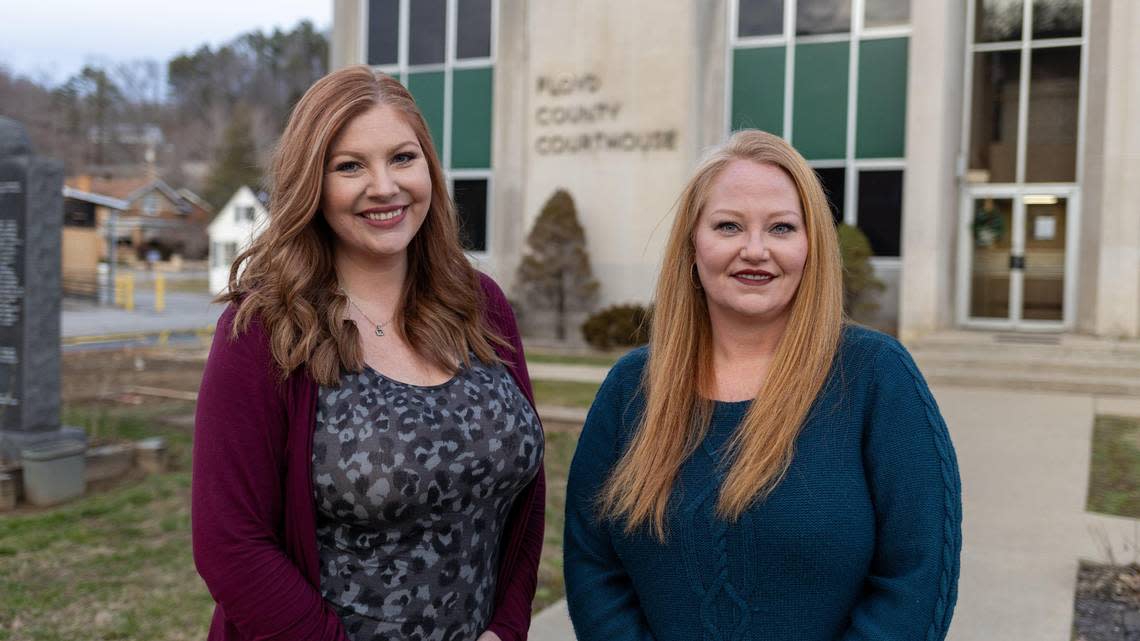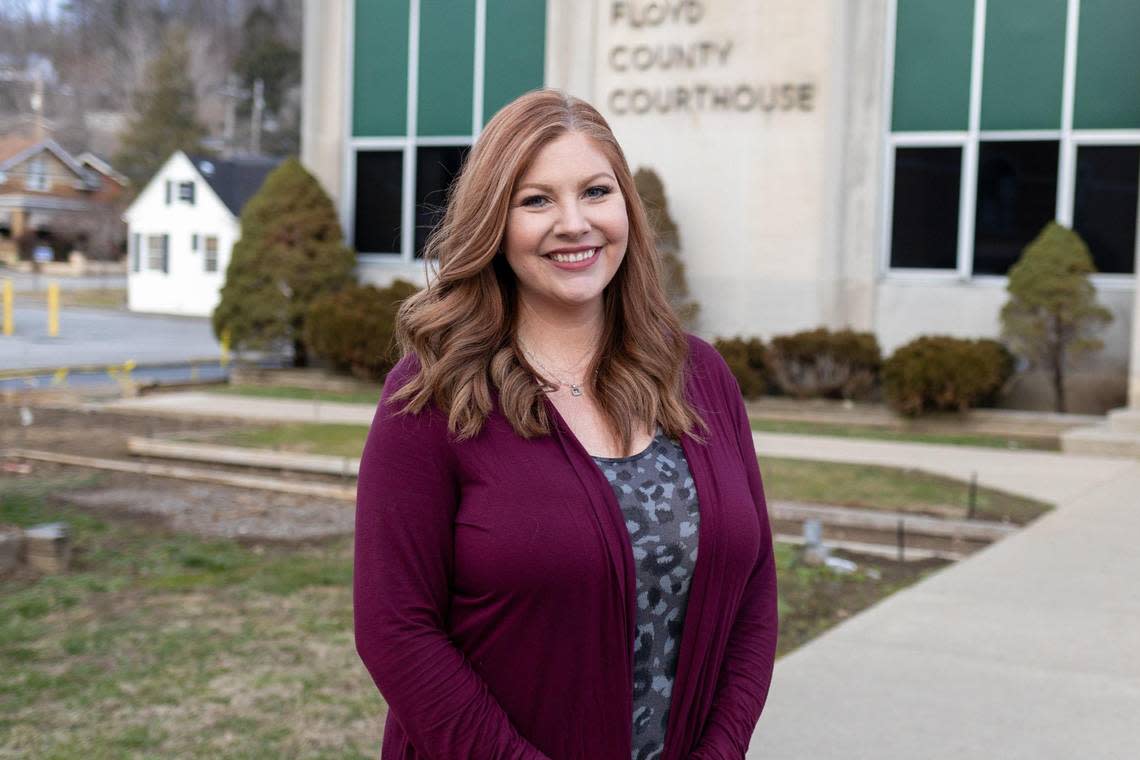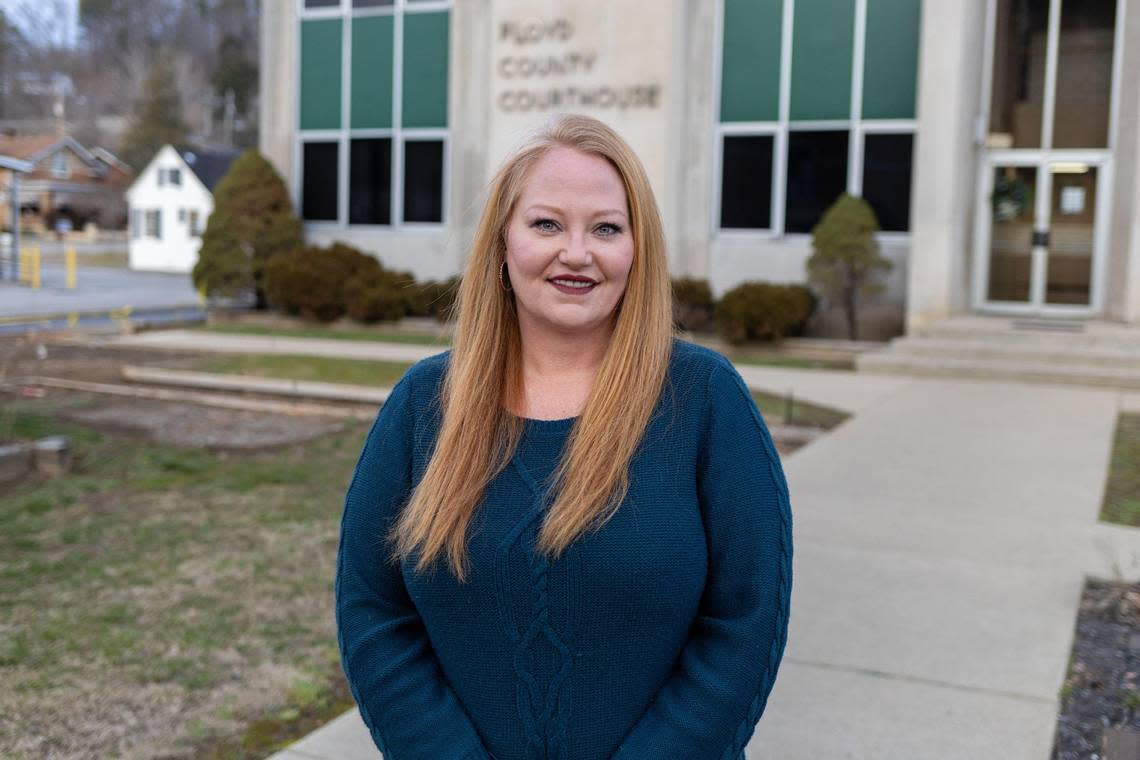Survivors of teacher sex abuse urge KY lawmakers to protect kids: ‘Secrets keep you sick’
Mary Prater and Jessica Hensley stood outside the Floyd County Courthouse in late November arm in arm as they turned to speak to reporters huddled near Prestonsburg’s main street.
Minutes before, longtime former Floyd County administrator, educator and coach April Bradford pleaded guilty to a host of charges related to the sexual abuse of the two women when they were teens.
There were people in Prestonsburg who considered Bradford a mentor, friend, a pillar of education in Floyd County. Why would they destroy Bradford’s life over something that happened years ago, some said on social media. Why did it take so long for the victims to come forward, others speculated.
Despite the whispers, the two women felt relief, vindication and freedom.
“It’s just a huge win for us. It’s been a long time coming,” Hensley told WYMT.
”It is freedom,” added Prater. “Freedom to those stilted little children that we had going on in our own bodies — the experience that we were having. Today, we experienced freedom; freedom for the truth.”
It was a secret both kept for decades.
“Secrets keep you sick,” said Hensley.
Bradford is one of dozens of teachers who have been arrested and charged in past years for sexually abusing students. From 2016 to 2021, the vast majority of teachers — 61 % —who lost or had their licenses suspended was due to sexual misconduct, a 2022 Lexington Herald-Leader investigation found.
Now a bill pending in the Kentucky General Assembly would make it more difficult for problematic teachers who have been accused of sexual misconduct from moving from school to school.

‘Buried it for years’
Prater and Hensley aren’t related. But the two look alike. As teenagers, both were athletes with strawberry blonde hair.
For Prater, the abuse started in 1997 when she was 13. Bradford was a teacher and her basketball coach. Hensley was also 13 when the abuse started in 2003. Bradford was also her coach and teacher.
Bradford was charming, encouraging and kind, both said. She was an expert at earning people’s trust. Not just their trust but the trust of their families and other school staff.
Sometimes the abuse would occur at school or on a bus.
“She would just put a coat over my lap,” Hensley said.
Prater said Bradford would come to her house. There were lots of gifts.
“We were special,” Prater said of how Bradford earned trust over time.
Sexual predators are often charming. They know how to use their authority to get what they want. They use their positions to fool not only the victim but those around the victim, Hensley said.
“It’s slow. It makes you feel like you’ve given consent,” Hensley said.
The abuse went on for years for both Prater and Hensley.

For Hensley, it went on until she was in her sophomore year of high school. A boy had asked her to prom. Hensley at first declined, but her mother questioned why her teenage daughter wouldn’t want to go to prom.
Bradford encouraged Hensley to go.
“April said we should ‘cool it’ for a couple weeks and encouraged me to go to prom as a cover-up. Once our ‘relationship’ was on a time-out, I never went back,” Hensley said. “I realized I could tell her ‘it was your idea to breakup’ without being the bad guy. In retrospect, this thinking makes me sad for my younger self.”
“I just buried it for years,” Prater said. “But I knew something was wrong.”
Hensley said she, too, didn’t fully understand what happened to her until she was in her late teens and early 20s.
Hensley moved out of the county when she was 25. She started talking to other people about it — people who never knew Bradford.
“I was able to start healing,” Hensley said.
In 2020, Prater caught her daughter talking to someone on FaceTime. Her daughter was 13 at the time, the same age she was when Bradford started to abuse her. The boy on the other end said he was 13. Prater grabbed the phone and demanded the boy show his face.
Prater was worried it was an adult. The boy eventually showed his face. He was 13.
“I just lost it,” Prater said.
Everything she had buried about Bradford and the abuse came back. She knew something was very, very wrong.
It can take years for victims of childhood sexual abuse to come forward, said Dr. Jacqueline Sugarman, an associate professor of pediatric medicine at the University of Kentucky and the medical director of the Children’s Advocacy Center of the Bluegrass. It conducts forensic interviews of children who have been abused.
“Some kids don’t have the language to express themselves,” Sugarman said. She knows of kids who didn’t realize they were being abused until there was a school presentation on child sexual abuse.
Sometimes the abuse can also start slowly and the child doesn’t understand what’s happening. And then when they do, “they are already deep into the situation. They can feel embarrassment. They can think they won’t be believed or they will be blamed.”
‘All in’
Gathering evidence wasn’t hard.
In old family scrapbooks there were photos of Bradford and Prater together. She found more than 20 videos of the two of them. At one point, Bradford had taken naked Polaroids of her. She didn’t have those but she knew someone in town who had seen those photos.
Prater took her evidence to authorities in January 2022. Meanwhile, Hensley’s older brother, who went to school with Prater, had heard about Prater going to law enforcement. He, too, had realized later Bradford was preying on both Prater and Hensley. He told Hensley. Hensley also came forward to authorities.
“When Mary said she was coming forward, I was all in,” Hensley said.
Hensley didn’t have the types of evidence Prater had.
Prosecutors kept the two women separate during the investigation so they could not compare stories.
But once they did talk, they heard the same horror story: the plot was the same but the victims were different.

Hensley and Prater said they want people to know why it can take years for childhood victims of sexual abuse to come forward.
“Sometimes it can take 20 years for you to put it together,” Hensley said. “It’s trauma. It’s like brain damage. Your frontal lobe is not fully developed until you are 25. When trauma like that happens, it can live with your forever.”
Unhealed and untreated trauma leads to substance abuse disorders and other mental illnesses, Prater said.
Sugarman said it can also lead to other problems including physical illnesses such as chronic pain conditions or gastrointestinal issues.
A 2018 study from John Hopkins University found the total economic impact of childhood sexual abuse in the United States is likely $9.3 billion — those costs including medical treatment, loss of productivity and therapy. Over the lifetime of female victims, that’s $282,734, the study found.
Sugarman said those numbers are conservative. Childhood sexual abuse is under-reported.
The outcomes for victims are better if the victim is believed, the perpetrator is caught and stopped, and the victim gets treatment, Sugarman said.
Guilt and self-blame is common for victims of sexual abuse, Prater and Hensley said.
Both have learned a lot as they have navigated through the trauma. They have advice for other victims of sexual abuse: Don’t blame yourself.
“Show yourself some kindness. You were a kid. You didn’t have a choice. You can’t make that kind of decision,” Hensley said.
‘Kids have permanent records, why not teachers?’
Bradford was arrested in June 2022 and originally charged with one count of second-degree sodomy, seven counts of third-degree sodomy, and 11 counts of unlawful transaction with a minor.
On Nov. 30, she pleaded guilty to eight counts of third-degree sodomy and 11 counts of first-degree sexual abuse. A special prosecutor with the state attorney general’s office was appointed to oversee the case.
As part of the plea deal, Bradford will serve three and a half years in jail. She will be sentenced in February.
A lawyer for Bradford declined to comment.
Both women are frustrated that more hasn’t been done to make it easier for childhood victims of sexual abuse to come forward and to root out teachers who prey on kids.
A bill proposed in the Kentucky General Assembly increases reporting requirements for teachers, making it more difficult for teachers who had previously been accused of sexual misconduct to move from school to school.
Under the bill, any prior allegation of sexual misconduct would be kept in the teacher’s file for a year. Teachers would also have to undergo training on appropriate boundaries between teachers and students.
A similar bill was proposed in 2023 but did not pass.
Both Prater and Hensley said the legislation is long overdue.
Hensley said she understands some teachers may have concerns about prior investigations in their permanent file.
“Students have permanent records, why not teachers?” Hensley said.
Prater said it’s also often difficult for students and teachers in small towns to report suspected sexual abuse. Everyone knows everyone. There are family, business and church ties.
People have also been conditioned to think sexual predators are strangers or Internet boogeyman.
“It’s someone the child knows,” Prater said.
Hensley works in mental health and with survivors of sexual abuse. The vast majority of survivors have been abused by a close family member or someone close to them, Hensley said. Sugarman agreed.
After Bradford was charged, multiple people reached out to Prater. At the time, many suspected Bradford’s relationship with a young, teenage girl was problematic.
“One woman who used to work at the school system told me how sorry she was. Everyone knew what was going on, but no one knew what to do about it,” Prater said.
